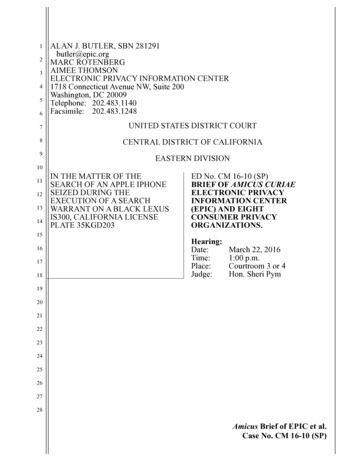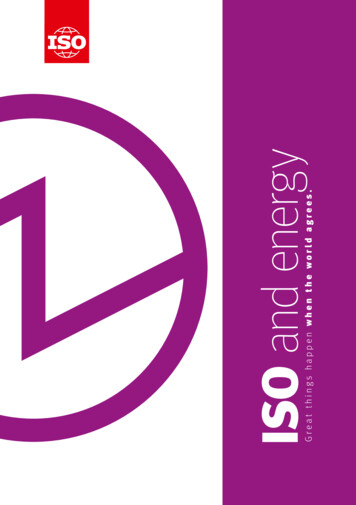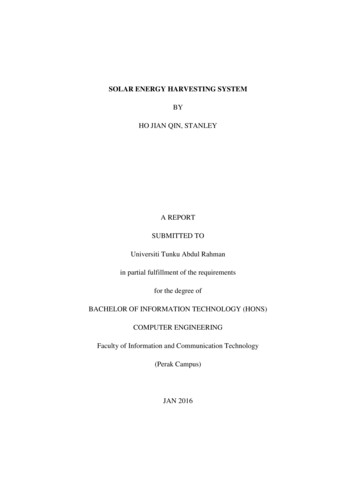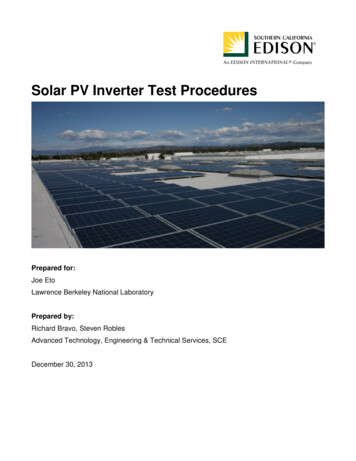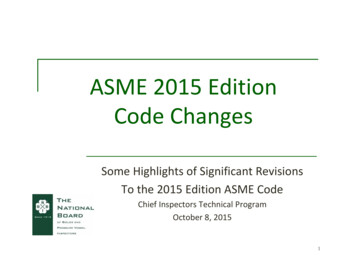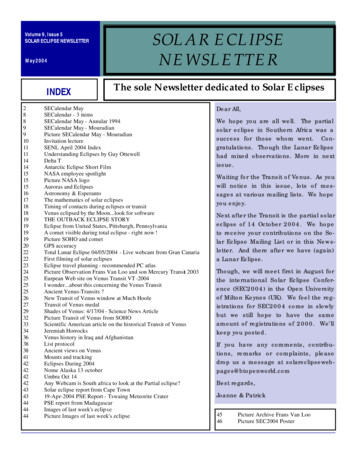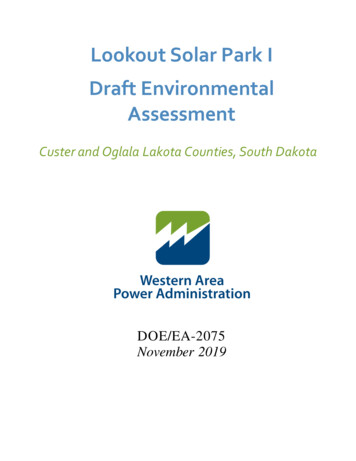
Transcription
Lookout Solar Park IDraft EnvironmentalAssessmentCuster and Oglala Lakota Counties, South DakotaDOE/EA-2075November 2019
Lookout Solar Park I Environmental AssessmentTable of Contents1.2.3.INTRODUCTION AND BACKGROUND . 11.1WAPA’s Authority . 11.2Lookout Solar’s Purpose and Need . 11.3Public Involvement. 11.4Tribal Consultation . 2PROPOSED ACTION AND ALTERNATIVES CONSIDERED . 22.1No Action Alternative . 22.2Alternatives Considered but Eliminated from Further Study . 22.3Proposed Action . 22.3.1 Solar Arrays . 32.3.2 Access Roads . 32.3.3 Construction Timing. 42.3.4 Operation . 42.3.5 Decommissioning and Reclamation . 4AFFECTED ENVIRONMENT AND ENVIRONMENTAL CONSEQUENCES . 73.1Soils and Geology . 73.1.1 Environmental Impacts: Proposed Action. 83.1.2 Environmental Impacts: No Action Alternative . 83.2Paleontology . 83.2.1 Environmental Impacts: Proposed Action. 93.2.2 Environmental Impacts: No Action Alternative . 93.3Air Quality and Emissions. 93.3.1 Environmental Impacts: Proposed Action.103.3.2 Environmental Impacts: No Action Alternative .103.4Vegetation .113.4.1 Environmental Impacts: Proposed Action.123.4.2 Environmental Impacts: No Action Alternative .133.5Water Resources .133.5.1 Environmental Impacts: Proposed Action.223.5.2 Environmental Impacts: No Action Alternative .233.6Threatened and Endangered Species.233.6.1 Environmental Impacts: Proposed Action and No Action Alternative .263.7Fish and Wildlife .263.7.1 Environmental Impacts: Proposed Action.303.7.2 Environmental Impacts: No Action Alternative .323.8Cultural Resources .323.8.1 Environmental Impacts: Proposed Action.323.8.2 Environmental Impacts: No Action Alternative .333.9Land Use .333.9.1 Environmental Impacts: Proposed Action.333.9.2 Environmental Impacts: No Action Alternative .343.10Socioeconomic Conditions .34
Lookout Solar Park I Environmental Assessment3.10.1 Environmental Impacts: Proposed Action.363.10.2 Environmental Impacts: No Action Alternative .363.11Visual Resources.363.11.1 Environmental Impacts: Proposed Action.373.11.2 Environmental Impacts: No Action Alternative .373.12Roads and Traffic .403.12.1 Environmental Impacts: Proposed Action.403.12.2 Environmental Impacts: No Action Alternative .403.13Cumulative Impacts .424.LIST OF PREPARERS .435.REFERENCES .44List of TablesTable 1-1.Table 2-1.Table 3-1.Table 3-2.Table 3-3.Table 3-4.Table 3-5.Table 3-6.Table 3-7.Table 3-8.Table 4-1.Table 4-2.Public Scoping Comments . 2Anticipated Surface Disturbance . 3Geology Summary of the Project Area. 7Soil Series Characteristics within the Project Area . 7Emission Sources. 10Vegetation in the Study Area. 11Federal T&E Species . 23State T&E Species . 29Minority Population Characteristics. 34Average Income and Poverty Rates (2010-2017). 35Preparers of the EA. 43Individuals Who Provided Technical Support, Management, and/or Review of the EA . 43List of FiguresFigure 1-1: Site Location Map . 1Figure 2-1: Project Area Overview . 5Figure 2-2: Solar Generating Facility Overview . 6Figure 3-1: Aquatic Resource Inventory of the Project Area and Transmission Line Route . 14Figure 3-2: Aquatic Resources of the Project Area . 15Figure 3-3: Cheyenne River Crossing . 16Figure 3-4: Angostura Canal Crossing . 17Figure 3-5: Cottonwood Creek Crossing . 18Figure 3-6: Cottonwood Cutoff Wetland Crossing . 19Figure 3-7: Substation Access Area Wetlands . 20Figure 3-8: FEMA Flood Zones in the Project Area. 21Figure 3-9: Whooping Crane Migration Corridor . 24Figure 3-10: Raptor Nests in the Project Area . 28Figure 3-11: View of the Southern Boundary of the Solar Generating Facility from BIA Route 2(Facing North) . 38Figure 3-12: View of the Approximate middle of the Solar Generating Facility (Facing South). 38Figure 3-14: Transportation Network . 41
Lookout Solar Park I Environmental AssessmentList of AppendicesAppendix A: Public Involvement InformationAppendix B: Aquatic Resource Inventory ReportAppendix C: Biological Resources Inventory ReportList of AcronymsBIABureau of Indian AffairsBORUnited States Bureau ofReclamationUnited States Department l AssessmentEnvironmental ProtectionAgencyFederal EmergencyManagement AgencyFinding of No SignificantImpactgreenhouse gasHDDkVLookout SolarMWHorizontal Directional DrillingKilovoltLookout Solar Park I, LLCmegawattsWAPANEPANWPO&MPRIRNational Environmental PolicyActNational Park ServiceNatural ResourcesConversation ServiceNationwide Permitoperations and maintenancePine Ridge Indian ReservationProjectPVReservationROWLookout Solar ProjectphotovoltaicPine Ridge Indian Reservationright-of-waySBHWSSouthern Black Hills outh Dakota Game, Fish, andParksState Historic PreservationOfficerSouthwest Power Poolthreatened and endangeredTribal Historic PreservationOfficeOglala Sioux TribeTrihydro CorporationUnited States Fish and WildlifeServiceUnited States Geological SurveyWestern Area PowerAdministration
Lookout Solar Park I Environmental AssessmentChapter 11. INTRODUCTION AND BACKGROUNDLookout Solar Park I, LLC (Lookout Solar) proposes to construct and operate the Lookout Solar Project(Project) on 810-acres located on the Pine Ridge Indian Reservation (PRIR or Reservation; Figure 1-1).Because the Project would be partially located on the PRIR, the Bureau of Indian Affairs (BIA), asrequired by their tribal trust responsibilities, reviewed the project to ensure that it complied with theNational Environmental Policy Act (NEPA), supported tribal sovereignty and self-determination, andmet the BIA’s mission. BIA prepared an Environmental Assessment (EA) in 2016 to analyze the partsof the Project within the PRIR. On June 7, 2016, the BIA determined the Project met the requirementslisted above and issued a Finding of No Significant Impact (FONSI).Since 2016, Lookout Solar submitted an interconnection request to Western Area Power Administration(WAPA) to connect the Project to WAPA’s transmission system. WAPA’s decision to grant or deny theinterconnection request is considered a federal action under NEPA. Therefore, WAPA prepared this EAto analyze the impacts of the interconnection, as well as portions of the Project located outside of thePRIR boundary, which were not analyzed in the BIA EA.1.1WAPA’s AuthorityWAPA’s action is to consider and respond to Lookout Solar’s interconnection request in accordancewith the Southwest Power Pool (SPP) Tariff (WAPA is a member of SPP) and the Federal Power Act.1.2Lookout Solar’s Purpose and NeedThe overall purpose of Lookout Solar’s Project is to generate and distribute solar photovoltaic (PV)energy, provide public education on the benefits of solar energy, encourage future renewable-energyinterest and investments, and reduce greenhouse gas (GHG) emissions.1.3Public InvolvementThere have been several opportunities for public involvement. In 2016, the BIA requested publiccomments from 32 local, state, and federal agencies; seven comments were received in response. TheBIA provided public notice of the EA and FONSI, also in 2016.Additionally, WAPA conducted public scoping between December 5, 2018 and February 16, 2019.WAPA requested public comments via a letter mailed to 52 local, state, and federal agencies and 19private landowners in the vicinity of the Project; seven comments were received in response. Table 1-1provides a brief summary of comments received; full comment letters and other public involvementinformation can be found in Appendix A. In addition, two open-house style public scoping meetingswere held, including a meeting on December 5, 2018 and a second meeting on January 16, 2019. Bothpublic meetings were held at the Hot Springs Public Library, in Hot Springs, SD. The second publicscoping meeting was scheduled as a result of a mandatory government furlough that prohibited keyWAPA personnel from attending the December 5th meeting. Approximately thirty members of thepublic attended the January 16, 2019 meeting. Newspapers announcements were published 15 days1
Lookout Solar Park I Environmental AssessmentChapter 1prior to the January 16, 2019 meeting including publications in the Rapid City Journal, Hot Springs Star,the Custer County Chronicle, and the Lakota Country Times.Table 1-1. Public Scoping CommentsParty ContactedPrivate CitizenSouth Dakota Departmentof Environment andNatural Resources(DENR)U.S. Department ofAgriculture Farm ServiceAgencySouth Dakota Game, Fish,and ParksSierra ClubU.S. Fish and WildlifeService (USFWS)1.4Comment SummaryConcern regarding project difficulties based on perceived problemswith the way previously proposed projects in area were handled (i.e.,wind farm).Construction using conventional construction techniques should notcause violation of statutes or regulations administered by the DENRbased on: 1. Controls for discharge of pollutants, 2. Surface waterdischarge permit(s) if any construction dewatering is to occur, andminimization of impacts to tributaries and wetlands.Requested additional detail of the Project in order to determine if anyFarm Service producers may be affected. Follow up letter indicatedno effect to producers.Concern for potential direct and indirect impacts to wildlife includinggrassland habitat and rare and protected species. Recommendedavoidance and mitigation measures for avian species, bats and othermammals, sensitive plants, and grassland habitat.Expressed general support for the Project and recommendedtransparency and engagement with tribal nations.Referred WAPA to obtain listed species information from theUSFWS Information for Planning Consultation (IPaC) website.Tribal ConsultationThe BIA and the Oglala Sioux Tribal Historic Preservation Office (THPO) consulted on the portions ofthe Project within the PRIR boundary, per Section 106 of the National Historic Preservation Act. TheBIA and Oglala Sioux Tribal Archeologist completed field surveys in 2015 and found no historicproperties. THPO concurrence was received on the survey results and determinations in 2015.In 2016, the Oglala Sioux Tribal Council issued a resolution (Resolution No. 16-50) in support of theProject.WAPA began consultation with the Oglala Lakota Nation by contacting their THPO, Mr. Tom Brings,by email on January 16, 2019. WAPA requested his comments on the project and provided him culturalresource documentation to review. Mr. Brings responded to WAPA’s January email on May 2, 2019,indicating that if any culturally significant tribal sites were discovered that they would have to beinventoried by a tribal representative.On April 8, 2019, WAPA provided Mr. Brings a copy of the final cultural resource inventory report forhis review and comment. No culturally significant tribal sites were identified in the report and Mr.Brings did not comment on the document.2
Lookout Solar Park I Environmental AssessmentChapter 1Figure 1-1: Site Location Map1
Lookout Solar Park I Environmental AssessmentChapter 22. PROPOSED ACTION AND ALTERNATIVES CONSIDEREDThis chapter describes the action WAPA and Lookout Solar propose to take (the Proposed Action), aswell as practical alternatives to the action.2.1No Action AlternativeUnder the No Action Alternative, WAPA would deny Lookout Solar’s interconnection request.Although the Project could pursue an interconnection with a private utility, for comparison purposes,this alternative assumes the Project would not be built. Current conditions would likely continue,including livestock grazing, which is the primary land use in the Project Area (described in Section 2.3).2.2Alternatives Considered but Eliminated from Further StudyDuring internal scoping, many alternatives were discussed and considered, including four differentproject locations and/or project sizes within the PRIR and two substation locations. These wereeliminated from further study due to potential issues with geology, migratory birds, viewsheds, and/oraccess.2.3Proposed ActionLookout Solar would construct, operate, and maintain the 110 megawatt (MW) Lookout Solargenerating facility, which would include the following components: Approximately 500,000 (covering 250 acres) solar panels, 4 miles of new access roads, A new 6 acre substation, A 0.5 acre Operations and Maintenance (O&M) facility, A 0.5 acre parking area, 11 miles of buried transmission line, A potential 0.1 acre energy storage facility, and Roughly 20 acres of laydown area for construction.The exact layout of the solar panels, storage facility, access roads, O&M facility, parking area, andlaydown areas has not been finalized, but the entire facility would be located within an 892-acre area inOglala Lakota and Custer Counties, South Dakota (Project Area; Figures 2-1 and 2-2). The 892-acreProject Area includes an 810-acre parcel of land where the generating facilities would be located, a 10acre parcel of land where the substation would be located, and a 72-acre Right-of-Way (ROW) wherethe transmission line would be buried. The anticipated surface disturbance is shown in Table 2-1.WAPA would enter into an Interconnection Agreement with SPP and Lookout Solar, which would allowthe Project to interconnect to WAPA’s existing New Underwood to Wayside 230 kV transmission line.Additionally, WAPA would make any necessary design or equipment changes to WAPA-ownedfacilities, as specified in the Interconnection Agreement, to accommodate the interconnection.2
Lookout Solar Park I Environmental AssessmentComponentChapter 2Table 2-1. Anticipated Surface ,22-3 acres per 1 MW3250O&M facility andParking Area0.5 acres for the warehouse, equipment storage, O&M facility,and 0.5 parking area1Access Roads4 miles of 12.5-foot wide roads2Substation500-foot by 500-foot substation area within a 10-acre parcel6Transmission LineRoute11 mile long transmission line (11 feet wide) consisting ofeighteen bundled 34.5 kilovolt (kV) transmission cables15Temporary LaydownArea20 acres20TOTAL2941Modules are also referred to as panels. Multiple modules or panels make up an array.Battery storage is included with this project component.3Average area requirements are dependent on the solar irradiation factor and can vary (Tisza 2014).22.3.1 Solar ArraysThe bottom edge of the PV panels would be 3-4 feet from the soil surface. The total height of the panelswould range from 12-13 feet, depending on the terrain. The panels would be situated at site-specificangles and mounted facing due south for maximum sunlight absorption; alternatively, solar trackers maybe used to allow the panels to rotate to follow the sunlight throughout the course of the day. Once thePV panels are installed, underground electrical wiring between each PV array would be connected. Theentire 250-acre array would be fenced for security.In the solar array locations, the area would be cleared, grubbed, and partially graded. Prior to grading,native topsoil would be removed from the area and stockpiled onsite for re-distribution over thedisturbed area after the grading is completed.Typical equipment needed for construction activities at the Project would include a compactor,impact/vibratory pilings or drill shafts, dump truck, dozer, excavator, generator, grader, pick-up trucks,and a crane.2.3.2 Access RoadsApproximately 4 miles of 12.5-foot-wide gravel access roads around the perimeter of the facility andbetween the solar blocks would be installed during the construction phase. Some of these access roadswould then be used during O&M activities after construction and would be maintained during the life ofthe project.3
Lookout Solar Park I Environmental AssessmentChapter 22.3.3 Construction TimingConstruction of the Project would take approximately 12 to 18 months, depending on the time of theyear when construction starts. The construction workforce could range between 50 workers up to 200workers.2.3.4 OperationOperating and maintaining the Project would include routine activities such as verifying connectionsthrough electrical tests and inspections, groundskeeping, and implementing repairs. If a solar panel isdamaged or faulty as identified through electric tests, then the solar panel will be replaced. Operationalactivities would require no more than three full-time employees. The Project would operate forapproximately 30 to 40 years.Vegetation on the Project would be actively maintained (mowed, trimmed, or removed) to controlgrowth and prevent overshadowing or shading of the solar PV arrays. Periodically, the solar moduleswould need to be washed. Washing would occur, at most, once per year. The necessary water would beobtained from the Mni Wiconi Water District or would be transported to the solar park by trucks.2.3.5 Decommissioning and ReclamationAt the end of the Project lifespan (30-40 years), Lookout Solar would assess whether to cease operationsor attempt to enter into a new power purchase contract. If a new power purchase agreement is reached,the Project could continue operating. If no arrangement is possible, the facilities would bedecommissioned and dismantled. In general, the majority of decommissioned equipment and materialswould be recycled. Materials that cannot be recycled would be disposed of at approved/permittedfacilities.General decommissioning activities would typically include: Dismantling and removing above ground equipment (e.g., solar panels, the substation, the O&Mfacility, etc.) Breaking up and removing concrete pads and foundations. Removing panel support posts.Abandoning the transmission line and underground utilities.4
Lookout Solar Park I Environmental AssessmentChapter 2Figure 2-1: Project Area Overview5
Lookout Solar Park I Environmental AssessmentChapter 2Figure 2-2: Solar Generating Facility Overview6
Lookout Solar Park I Environmental AssessmentChapter 33. AFFECTED ENVIRONMENT AND ENVIRONMENTAL CONSEQUENCESThis chapter describes the existing environment, as well as the expected environmental consequences ofthe Proposed Action and the No Action Alternatives. The affected environment is described for eachresource based on a review of existing data, and for some resources, field investigations. The StudyArea included the 892-acre Project Area buffered by 0.5 miles (for a total of 9,803 acres) to account forindirect impacts to natural resources.3.1Soils and GeologyWithin the region, Pierre Shale overlays the Niobrara Formation and Carlile Shale. The Carlile Shaleand the Niobrara Formation date back to the Late Cretaceous age. These rock units are primarilyexposed in the valley of the White River in the PRIR. Table 3-1 provides a summary of these geologicunits.Table 3-1. Geology Summary of the Project AreaStratigraphic Unit AgeRock Composition DescriptionOligoceneclaystone, sandstoneWhite RiverGroupLate Cretaceousshale, sandstone, limestoneCarlile ShaleFormationLate CretaceouslimestoneNiobraraFormationLate Cretaceousshale, evaporitePierre ShaleSource: USGS 2014There are 26 unique soils within the Project Area (Table 3-2). The five most common soil types aredescribed in Table 3-2.Table 3-2. Soil Series Characteristics within the Project AreaPercent (%)of theProjectAreaSoil SeriesLandscape LocationTextureAcres inthe ProjectAreaAnselmo-ValentineComplexStable, uniform slopes. 5-10%slope.Gently sloping to rollinghillslopes on uplands. 3-9%slope.Uplands and high terraces. 03% slope.Shorter, steeper slopes andupper ridges and knolls. 330% slope.Sandy loam tofine sandy loam43248Clay to siltyclay1401612214688Pierre ClayRichfield-AltvanSilt LoamsValentine SandSilt loam to siltyclay loamLoamy finesand to coarsesand7
Lookout Solar Park I Environmental AssessmentChapter 3Table 3-2. Soil Series Characteristics within the Project AreaSoil SeriesLandscape LocationTextureAcres inthe ProjectAreaTuthill-AnselmoFine Sandy LoamsHigh terraces and tablelands.3-9% slope.Sandy to loamy34Percent (%)of theProjectArea4Source: Radeke 19713.1.1 Environmental Impacts: Proposed ActionThe soils in the area are generally stable and suitable for standard construction techniques. Up to 275acres of soils would be temporarily impacted. Short-term impacts would occur, primarily, as a result ofland clearing and leveling during the site preparation process. Additionally, borrow material (sandand/or gravel), may be required for site grading and foundation construction for the Proposed Action. Ifborrow material is needed, then these resources would be obtained from off-site sources. The types ofshort-term impacts are likely mixing of soil layers, soil compaction, and sediment runoff or erosion.Operation of the facility would have a long-term impact to approximately 250 acres of soils. Permanentimpacts are expected at the solar panel support footings, fence post sites, access roads, building andequipment foundations, and parking areas. Routine maintenance activities, such as fence repair,vegetation control, and vehicle inspections, could also disturb soils.To limit these impacts, the following measures would be implemented: Utilize the existing landscape (e.g., slope, drainage, use of existing roads), where feasible, tominimize or eliminate grading work and land disturbance. Use appropriate controls (e.g., silt fences, riprap, etc.) to minimize soil exposure and to preventeroded soil from leaving the disturbed area. Stockpile the topsoil separately and redistribute it after grading is complete. Work during dry conditions, whenever possible, to minimize rutting, erosion, and runoff.Disturbed areas would be regraded to approximate original contours and revegetated with a nativeplant community in accordance with the guidance of the DENR.Develop and implement a Stormwater Pollution Prevention Plan.The Project would contribute to the Region-wide trend of development, which increases the risk of soilerosion, sedimentation, mixing, and compaction.3.1.2 Environmental Impacts: No Action AlternativeThis Alternative would have no new impact to soil or geology resources. Existing livestock grazingpractices are expected to continue. Livestock over-grazing is known to increase erosion and runoff.3.2PaleontologyThe Badlands in western South Dakota are thought to contain the richest fossil beds in the world. Thefossils from the White River Group in South Dakota preserve the entire late Eocene through the middle8
Lookout Solar Park I Environmental AssessmentChapter 3Oligocene periods, roughly 30-35 million years ago and more than 30 million years after non-aviandinosaurs became extinct (Benton et al. 2015). The White River Group ranges from 0 to 300 feet indepth. The White River Badlands include Badlands National Park, which is known as the birthplace of“vertebrate paleontology” because of the discovery of fossils of animals with backbones in the area(National Park Service [NPS] n.d.). The White River Badlands are located east/southeast of the ProjectArea but are within the Study Area.Oral traditions among the Oglala Lakota Nation note the discovery of fossilized bones, turtle shells, andseashells throughout the area. Although the presence of paleontological resources is unknown withinthe Study Area, it is assumed that paleontological resources could exist in the area due to the highoccurrence of these resources in surrounding areas.3.2.1 Environmental Impacts: Proposed ActionWhile the White River Group was identified within the Study Area, it is outside the Project Area whereconstruction activities would occur. Regardless, due to the potential to encounter paleontologicalresources, Lookout Solar intends to have a qualified construction/archaeologist monitor present duringground disturbing activities. In the
Geology Summary of the Project Area . with the way previously proposed projects in area were handled (i.e., wind farm). South Dakota Department . WAPA began consultation with the Oglala Lakota Nation by contacting their THPO, Mr. Tom Brings , by email on January 16, 2019. WAPA request


